- Tutorials
- Blocks ( 막기 makgi )
- Trunk Push Low Block ( 아래 헤쳐막기 arae-hecho-makgi )
Taekwondo 태권도Taekwondo Preschool
When you reach senior belt you are expected to guide the junior belts when they are beginning Taekwondo such as showing by example. To advance from one rank to the next, students typically complete promotion tests in which they demonstrate their proficiency in the various aspects of the art before a panel of judges or their teacher. View Taekwondo belt levels »

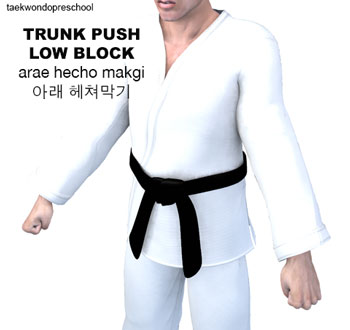


Trunk Push Low Block
아래 헤쳐막기 arae-hecho-makgi
Difficulty Level: Intermediate Technique: Blocks ( 막기 makgi )
This block ( 막기 makgi ) technique requires both forearms to be bent and raised to shoulder height level to form a cross. Then snap both arms straight down like a low block ( 아래막기 arae-makgi ) to the right and left sides. This technique blocks ( 막기 makgi ) any incoming low kicks or low strikes to the side. Remember with both hands down that the upper section is vulnerable to attacks.
Focus on the tightening of the muscles of the hand while you clench a fist ( 주먹 jumeok ). The wrist ( 팔목 palmok ) must also be kept straight in proper alignment during the posture. If the wrist ( 팔목 palmok ) bends on impact, it can easily be sprained, dislocated or broken.
Experienced blockers learn through repetition and muscle memory when (not just how) to launch particular blocks ( 막기 makgi ), based on the circumstances they are facing. Fights and fighters may have ebbs and flows in momentum and action that become predictable. Disrupting this flow may give the blocker an advantage.
Training Methods
How well one improves with training depends on several factors, such as the frequency it is engaged in, and the type of feedback that is available for improvement. If a student does not train often enough, reinforcement fades, and he or she is likely to forget what was learned.
When learning the block ( 막기 makgi ), it is helpful to use mirrors to observe your technique and fix your mistakes immediately. Initially, a student may need focused feedback from a certified Master Instructor ( 사범님 sabeomnim ); however, as they progress, they must develop the ability to self-assess the block ( 막기 makgi ).
The technique is also learned by blocking in the air as though there is an opponent striking but focusing on the form, speed, and technique; then moving on to partner training (self-defence scenarios, sparring practices, one-step sparring, etc) reinforcing the block ( 막기 makgi ) on a realistic moving attack.
Difficulty of Technique
Taekwondo students of geup ranking learn the most basic techniques first, and then move on to more advanced and difficult techniques as they approach 1st Dan Black Belt. The more difficult the technique, the more practice may be needed for the purpose of improving or mastering it, as in the phrase 'practice makes perfect'. Every technique must display the requisite speed, balance, power and firmness to be realistically used as an attack or defense move.
* Please see a certified Master Instructor ( 사범님 sabeomnim ) for training. Proper guidance and instructions are needed to ensure safe training.
Promotion Tests
Students often undergo periodic testing and grading by their own Master Instructor ( 사범님 sabeomnim ) in order to advance to a higher level of recognized achievement such as a different belt color. They need to demonstrate their proficiency in the various aspects of the art such as the execution of patterns ( 품새 poomse ), which combine various techniques in specific sequences.
Trunk Push Low Block ( 아래 헤쳐막기 arae-hecho-makgi ) is a requirement for the below belt levels (Techniques vary between schools). Promotion from one belt level to the next can proceed rapidly in some schools, since schools often allow geup promotions every two, three, or four months. Students of geup rank learn the most basic techniques first, and then move on to more advanced techniques as they approach first dan black belt. View Promotion Tests »
Advertisement
Trunk Push Low Block ( 아래 헤쳐막기 arae-hecho-makgi )
Blocking Surface
Various surfaces of the body may be engaged as the blocking surface depending on which area of the body is being targeted. This leads to a large array of blocking positions. For more information on Impact Surface Areas »
( Click image for additional information)
Technique Injuries
Collisions with the ground, objects, and other taekwondo practitioners are common, and unexpected dynamic forces on limbs and joints can cause injury. Taekwondo injuries can also occur in techniques if done improperly or from overuse of a particular body part. Taking a break from training or reducing the volume and the intensity of the training will allow the body to recover. For more information on Injuries »
( Click image for additional information)
Common Mistakes when Performing the Technique
When performing the technique, there will be more mistakes as a beginner and as the practitioner advances through the rankings, they will have learned and improved from the past. How well one improves with training depends on several factors, such as the frequency it is engaged in, and the type of feedback that is available for improvement.
( Click image for additional information)
Some Technique(s) to Block Against
Blocking ( 막기 makgi ) is the act of stopping or deflecting an opponent's attack for the purpose of preventing injurious contact with the body in either sparring ( 겨루기 gyeorugi ) or for self-defense ( 호신술 hosinsool ) applications. Experienced practitioners learn through repetition and muscle memory when (not just how) to launch particular blocks ( 막기 makgi ), based on the circumstances they are facing.
( Click image for additional information)
Some Counterstrike Combinations after the Block ( 막기 makgi )
After a successful block ( 막기 makgi ) the taekwondo practitioner may immediately counterattack to the opponent with a kick ( 차기 chagi ) or punch ( 지르기 jireugi ). When the opponent is attacking, they may leave themselves vulnerable in some areas such as recovering from a technique, positioning, imbalance, and more. Practitioners may combine techniques in a series to ensure one or more strikes impact their opponents.
( Click image for additional information)
Some Stance(s) ( 서기 sogi ) used with this Block ( 막기 makgi )
An example of the union of mental and physical discipline is the combination of stance ( 서기 sogi ), footwork ( 딛기 ditgi ), and technique (either with kick, block and/or strike), which requires both physical mastery of the technique and the concentration to focus one's power. Experienced practitioners learn through repetition and muscle memory when (not just how) to launch particular techniques, based on the circumstances they are facing.
( Click image for additional information)
Trunk Push Low Block ( 아래 헤쳐막기 arae-hecho-makgi )
Use in Sparring ( 겨루기 gyeorugi )
Under World Taekwondo (WT) and Olympic rules, sparring is a full-contact event and takes place between two competitors in an area measuring 8 meters square. A win can occur by points, or if one competitor is unable to continue (knockout) the other competitor wins. Points are awarded for permitted, accurate, and powerful techniques to the legal scoring areas; light contact does not score any points. For more information on World Taekwondo (WT) Tournament Sparring » 
The Trunk Push Low Block ( 아래 헤쳐막기 arae-hecho-makgi ) is not used in World Taekwondo (WT) sparring due to its awkward non-effective use in competitive sparring. With both hands down, the blocking technique would leave the practitioner vulnerable in the upper torso and the upper head sections.
( Click image for additional information)
Use in Self-Defense ( 호신술 hosinsool ) Applications
Self-Defense is to protect yourself from being attacked from would-be aggressors. It is a countermeasure that involves defending the health and well-being of oneself from harm and is designed primarily to cause injury or quickly incapacitate an attacker, in addition to being a deterrent against them. Attackers are typically larger, stronger, and are often armed or have an accomplice. With proper execution attackers may be incapacitated with a single blow, which lessens the number of attacks with multiple people. For more information on Self-Defense ( 호신술 hosinsool ) »
Each technique must be correctly timed and aligned in order to defend effectively. Taekwondo practitioners must have their body weight correctly distributed during the stance ( 서기 sogi ) including proper footwork ( 딛기 ditgi ). The block ( 막기 makgi ) is performed during Self-Defense ( 호신술 hosinsool ) scenarios.
( Click image for additional information)
Use in One-Step Sparring
One-Step Sparring is performed with a partner in which predefined movements are practiced. One student is the attacker while the other student responds with defenses, counterattacks, and/or other actions, based on part of the predefined movements. For more information on One-Step Sparring »
The block ( 막기 makgi ) is not featured during One-Step Sparring practice. Fundamentally, taekwondo One-Step Sparring is one of the learning grounds for real combat. As such, every technique including stance ( 서기 sogi ) must display the requisite speed, power and firmness to be realistically used as an attack or defense move. One-Step Sparring varies between schools.
( Click image for additional information)
Use in Breaking ( 격파 gyeokpa )
The discipline of destroying inanimate objects such as wooden boards, baseball bats, ice blocks or cement bricks and is a feature common to martial arts including taekwondo. A single board or stack of boards may be broken or, alternatively, a series of boards may be broken in a pre-set sequence utilizing a variety of strikes. Advanced competitors may even break several boards in a single jump with multiple kicks before landing. For more information on Breaking ( 격파 gyeokpa ) »
In use, the block ( 막기 makgi ) is not featured during Breaking ( 격파 gyeokpa ) events. General qualities that judges look for in any taekwondo practitioner include proper breathing technique and body control. The diaphragm must be engaged in deep breathing, shallow breathing concentrated in the upper abdomen results in raised shoulders and stressed muscles. Breaking ( 격파 gyeokpa ) varies between schools.
( Click image for additional information)


Did you know?
Back Stance ( 뒷굽이 dwi-kubi )


This stance ( 서기 sogi ) is specifically focused on shifting weight to the back leg, as it offers much more control, and makes it easier to kick off the front leg. To perform the Back Stance ( 뒷굽이 dwi-kubi ), the body faces to the side, with the front foot facing forward and the front leg bent. The back leg is bent slightly and the foot is turned outwards perpendicular to the front foot making the letter "L" for this stance ( 서기 sogi ). When learning the Back Stance ( 뒷굽이 dwi-kubi ), it is helpful to use a mirror. For more information View Back Stance ( 뒷굽이 dwi-kubi ) »
| Hangul 한글 | Korean | Belt Requirement | Difficulty Level | Tutorial | |
| Attention Stance | 차렷 | charyeot |   |
Beginner Level | Tutorial » |
| Ready Stance | 기본준비 | junbi |   |
Beginner Level | Tutorial » |
| Front Stance | 앞굽이 | ap-kubi |   |
Beginner Level | Tutorial » |
| Walking Stance | 앞서기 | ap-sogi |   |
Beginner Level | Tutorial » |
| Parallel Stance | 나란히서기 | naranhi-sogi |   |
Beginner Level | Tutorial » |
| Inward Stance | 안쫑서기 | anjjong-sogi |   |
Beginner Level | Tutorial » |
| At Ease Stance | 편히서기 | pyeoni-sogi |   |
Beginner Level | Tutorial » |
| Back Stance | 뒷굽이 | dwi-kubi |    |
Intermediate Level | Tutorial » |
RESOURCES
This article uses material from the Wikipedia article "Taekwondo Stances" which is released under the Creative Commons Attribution-Share-Alike License 3.0.
Advertisement
Trunk Push Low Block ( 아래 헤쳐막기 arae-hecho-makgi )
Use in Patterns ( 품새 poomse )
Block is introduced in the following pattern:
TAEGEUK #: 6
PALGWE #: 7
BLACK BELT: Keumgang 품새 금강 ( 2nd Dan )
Poomse is the foundation for the teaching of taekwondo. A poomse or form is a detailed pattern of defense-and-attack motions and techniques used in traditional martial arts. Poomse is useful in developing proper kinetics, mental and physical fortitude.
( Click image for additional information)
Most Kukkiwon 국기원 schools will use the poomse taegeuk whereas a few schools will use the poomse palgwe. The meanings, trigrams and symbols are shared by both poomse taegeuk and poomse palgwe, however the sequence of movements is different. The first 8 forms of the set of poomse differ from each other, whereas the last 9 forms (Black Belt forms) of the set are shared between the two sets. All students studying in World Taekwondo (WT) Kukkiwon style must learn these forms, or taegeuk, to advance to a higher belt level. There are eight taegeuk forms, each one similar to the previous one, but each time with more complicated techniques to display the students' mastery of the techniques learned during lessons, as well as the ability to interconnect these techniques.
For more information on taekwondo patterns refer to Poomse 품새 Section »
Learn other taekwondo blocks on the Main Blocking ( 막기 makgi ) Section »
Experienced practitioners learn through repetition and muscle memory when (not just how) to launch particular blocks, based on the circumstances they are facing. Fights and fighters may have ebbs and flows in momentum and action that become predictable. Disrupting this flow may give the striker an advantage.
Use in Demonstrations
To promote taekwondo for its emphasis on high kicking and fast hand techniques, taekwondo schools perform at tournaments, community events, shopping malls, parks, and tv shows. Demonstrations vary from school to school, but may include such elements as the execution of poomse ( 품새 poomse ), which combine various techniques in specific sequences; the breaking of boards to demonstrate the ability to use techniques with both power and control; sparring ( 겨루기 gyeorugi ) and self-defense ( 호신술 hosinsool ) to demonstrate the practical application and control of techniques; physical fitness usually with push-ups and sit-ups. For more information on Demonstrations »
The block ( 막기 makgi ) is commonly used in demonstration activities such as when performing poomse ( 품새 poomse ) which is the foundation for the teaching of taekwondo. A poomse ( 품새 poomse ) is a series of movements linked together in a prescribed sequence which is significant to demonstrate. As such, every technique must display the requisite speed, power and firmness to be realistically used as an attack or defense move.
( Click image for additional information)
Use in Warming-Up
A warm-up generally consists of a gradual increase in intensity in physical activity, joint mobility exercise, and stretching, followed by the activity. Warming-up brings the body to a condition at which it safely responds to nerve signals for quick and efficient action. For more information on Warming-Up »
In addition to being a block ( 막기 makgi ) in itself, the block ( 막기 makgi ) is an exercise used by many instructors to teach the principle of focusing, stretching, relaxing the muscles, increasing the range of motion and flexibility, something which is considered important in taekwondo. The result is a feeling of increased muscle control, flexibility and range of motion.
( Click image for additional information)
Trunk Push Low Block ( 아래 헤쳐막기 arae-hecho-makgi )

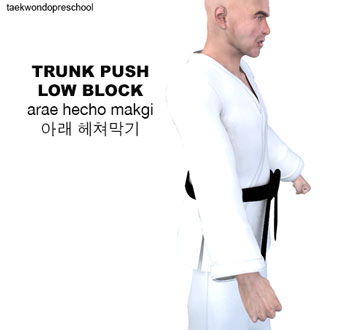
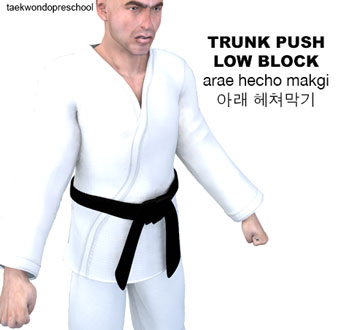

Training Highlights Summary
The Trunk Push Low Block ( 아래 헤쳐막기 arae-hecho-makgi ) contains many key point highlights. There are some that are simple and straightforward but then some are complex and detailed that require repeated training to learn and master.
- both forearms to be bent and raised to shoulder height level to form a cross
- then snap both arms straight down like a low block ( 아래막기 arae-makgi ) to the right and left sides
- focus on the tightening of the muscles of the hand while you clench a fist ( 주먹 jumeok )
- wrist ( 팔목 palmok ) must also be kept straight in proper alignment during the posture
Precision of Blocking ( 막기 makgi ) Technique
Depending on the strike, one may block ( 막기 makgi ) an attack most commonly by placing a limb across the line of the attack. Some techniques can block and deflect an attack with more precision which allows an effective counterstrike. The below is an approximate measurement of how precise the block requires from the practitioner to be effective.
Experienced practitioners learn through repetition and muscle memory when (not just how) to launch particular blocks ( 막기 makgi ), based on the circumstances they are facing.
* Please see a certified Master Instructor ( 사범님 sabeomnim ) for training. Proper guidance and instructions are needed to ensure safe training.
Additional Resources
Taekwondo Blocks ( 막기 makgi )
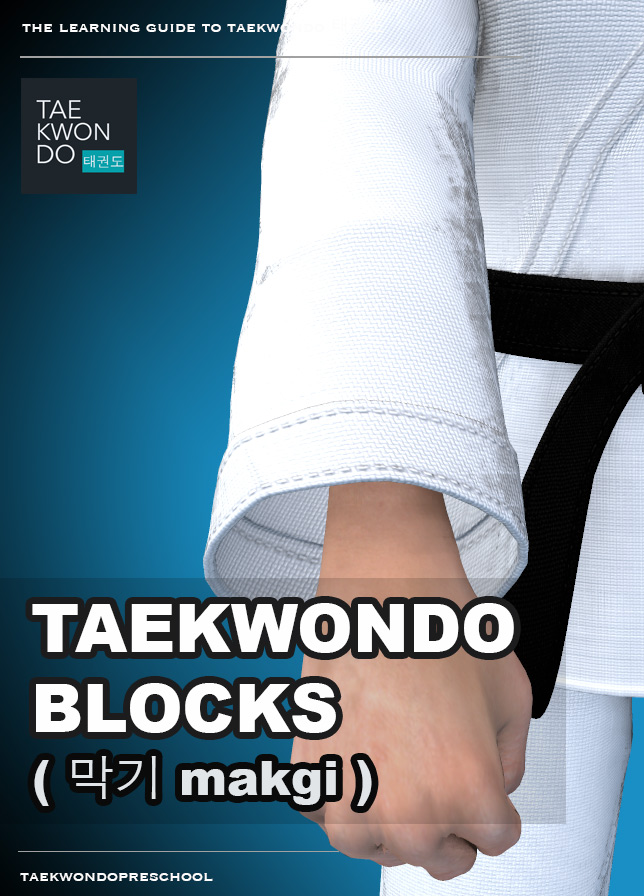
This book is available for download with Apple Books on your Mac or iOS device, and with iTunes on your computer. Book can be read with Apple Books on your Mac or iOS device.
In taekwondo and other martial arts, blocking ( 막기 makgi ) is the act of stopping or deflecting an opponent's attack for the purpose of preventing injurious contact with the body. A block ( 막기 makgi ) usually consists of placing a limb across the line of the attack. Blocks ( 막기 makgi ) are considered by some to be the most direct and least subtle of defensive techniques.
View more information about Book »
TAEKWONDO BLOCKS ( 막기 makgi ) |
|||||
| Hangul 한글 | Korean | Belt Requirement | Difficulty Level | Tutorial | |
| Low Block | 아래막기 | arae-makgi |    |
Beginner Level | Tutorial » |
| Middle Block | 몸통막기 | momtong-makgi |    |
Beginner Level | Tutorial » |
| High Block | 올려막기 | olgul-makgi |    |
Beginner Level | Tutorial » |
| Inner Wrist Outer Block | 안팔목 바깥막기 | anpalmok-bakkat-makgi |   |
Intermediate Level | Tutorial » |
| Single Knife Hand Outward Block | 한손날 바깥막기 | hansonnal-bakkat-makgi |   |
Intermediate Level | Tutorial » |
| Low Side Block | 아래 옆막기 | arae-yeop-makgi |   |
Intermediate Level | Tutorial » |
| Hand Blade Low Block | 한손날 아래막기 | sonnal-arae-makgi |   |
Intermediate Level | Tutorial » |
| Supported Hand Blade Block | 손날 거들어 바깥막기 | sonnal-kodureo-makgi |    |
Intermediate Level | Tutorial » |
| Pressing Block | 눌러막기 | nulleo-makgi |    |
Intermediate Level | Tutorial » |
| Palm Heel Pressing Block | 바탕손 눌러막기 | batangson-nulleo-makgi |    |
Intermediate Level | Tutorial » |
| Outside Wrist Pressing Block | 바깥팔목 눌러막기 | bakkatpalmok-nulleo-makgi |    |
Intermediate Level | Tutorial » |
| Outside Block | 바깥막기 | bakkat-makgi |    |
Intermediate Level | Tutorial » |
| High Outside Block | 올려 바깥막기 | olgul-bakkat-makgi |   |
Intermediate Level | Tutorial » |
| Trunk Push Low Block | 아래 헤쳐막기 | arae-hecho-makgi |  |
Intermediate Level | Tutorial » |
| Cross Block | 엇걸어막기 | otgoreo-makgi |  |
Intermediate Level | Tutorial » |
| Low Cross Blocking | 아래 엇걸어막기 | arae-otgoreo-makgi |  |
Intermediate Level | Tutorial » |
| High Cross Blocking | 올려 엇걸어막기 | olgul-otgoreo-makgi |  |
Intermediate Level | Tutorial » |
| Hand Blade High Cross Block | 손날 엇걸어막기 | sonnal-olgul-otgoreo-makgi |  |
Intermediate Level | Tutorial » |
| Inward Knife Hand Block | 손날 안막기 | sonnal-an-makgi |   |
Intermediate Level | Tutorial » |
| Palm Heel Inward Block | 바탕손 안막기 | batangson-an-makgi |   |
Intermediate Level | Tutorial » |
| Supported Downward Hand Blade Block | 손날 거들어 내려막기 | sonnal-kodureo-naeryeo-makgi |   |
Intermediate Level | Tutorial » |
| Hand Blade Twisting Outward Block | 손날 비틀어 바깥막기 | sonnal-bakkat-bitureo-makgi |   |
Intermediate Level | Tutorial » |
| Palm Heel Assisted Block | 바탕손 거들어 몸통막기 | batangson-kodureo-momtong-makgi |   |
Intermediate Level | Tutorial » |
| Trunk Push Double Block | 헤쳐막기 | hecho-makgi |   |
Intermediate Level | Tutorial » |
| Outside Wrist Double Block | 바깥팔목 헤쳐막기 | bakkat-palmok-hecho-makgi |   |
Intermediate Level | Tutorial » |
| Inside Wrist Double Block | 안팔목 헤쳐막기 | anpalmok-hecho-makgi |   |
Intermediate Level | Tutorial » |
| Side Block | 옆막기 | yeop-makgi |   |
Intermediate Level | Tutorial » |
| Inside Wrist Side Block | 안팔목 옆막기 | anpalmok-yeop-makgi |   |
Intermediate Level | Tutorial » |
| Outside Wrist Side Block | 바깥팔목 옆막기 | bakkat-palmok-yeop-makgi |   |
Intermediate Level | Tutorial » |
| Hand Blade Side Block | 손날 옆막기 | sonnal-yeop-makgi |   |
Intermediate Level | Tutorial » |
| Scissors Blocking | 가위막기 | kawi-makgi |    |
Advanced Level | Tutorial » |
| Supported Trunk Block | 거들어막기 | momtong-kodureo-makgi |  |
Advanced Level | Tutorial » |
| Outside Wrist Supporting Outward Block | 바깥팔목 거들어 바깥막기 | bakkatpalmok-kodureo-bakkat-makgi |  |
Advanced Level | Tutorial » |
| Supported Downward Block | 거들어 내려막기 | kodureo-naeryeo-makgi |  |
Advanced Level | Tutorial » |
| Hand Blade Double Block | 손날 헤쳐막기 | sonnal-hecho-makgi |   |
Advanced Level | Tutorial » |
| Single Hand Wide Open Block | 외산틀막기 | wesanteul-makgi |   |
Advanced Level | Tutorial » |
| Wide Open Mountain Block | 산틀막기 | santeul-makgi |  |
Advanced Level | Tutorial » |
| Diamond Blocking | 금강막기 | keumgang-makgi |  |
Advanced Level | Tutorial » |
| Keumgang Downward Side Block | 금강 내려 옆 막기 | keumgang-naeryeo-yeop-makgi |  |
Advanced Level | |
| Keumgang Outward Block | 금강 바깥막기 | keumgang-bakkat-makgi |  |
Advanced Level | |
| Hand Blade Diamond Downward Side Block | 손날 금강 내려 옆 막기 | sonnal-keumgang-naeryeo-yeop-makgi |  |
Advanced Level | |
| Hand Blade Diamond Outward Block | 손날 금강 바깥막기 | sonnal-keumgang-bakkat-makgi |  |
Advanced Level | |
| Bent Wrist Outward Block | 굽힌손목 바깥막기 | gupinsonmok-bakkat-makgi |  |
Advanced Level | Tutorial » |
| Bull Horn Blocking | 황소막기 | hwangso-makgi |  |
Advanced Level | Tutorial » |
| Ridgehand Outward Block | 손날등 바깥막기 | sonnal-deung-bakkat-makgi |  |
Advanced Level | Tutorial » |
| Ridgehand Side Block | 손날등 옆막기 | sonnal-deung-yeop-makgi |  |
Advanced Level | Tutorial » |
| Ridgehand Double Block | 손날등 헤쳐막기 | sonnal-deung-hecho-makgi |  |
Advanced Level | Tutorial » |
| Ridgehand Supported Downward Block | 손날등 거들어 내려막기 | sonnal-deung-kodureo-naeryeo-makgi |  |
Advanced Level | Tutorial » |
| Inner Wrist Supporting Side Block | 안팔목 거들어 옆막기 | anpalmok-kodureo-yeop-makgi |  |
Advanced Level | Tutorial » |
| Inner Wrist Supporting Outward Block | 안팔목 거들어 바깥막기 | anpalmok-kodureo-bakkat-makgi |  |
Advanced Level | Tutorial » |
| Palm Assisting Outer Block | 손바닥 거들어 바깥막기 | sonbadak-kodureo-bakkat-makgi |  |
Advanced Level | Tutorial » |
| Target Block | 표적 막기 | pyojeok-makgi |  |
Advanced Level | Tutorial » |
| Underneath Target Block | 아래 표적 막기 | arae-pyojeok-makgi |  |
Advanced Level | Tutorial » |
| Kicking Block | 차막기 | cha-makgi |  |
Advanced Level | Tutorial » |
| Outward Kicking Block | 바깥 차막기 | bakkat-cha-makgi |  |
Advanced Level | Tutorial » |
| Inward Kicking Block | 안 차막기 | an-cha-makgi |  |
Advanced Level | Tutorial » |
| Front Kicking Block | 앞 차막기 | ap-cha-makgi |  |
Advanced Level | Tutorial » |
| Side Kicking Block | 옆 차막기 | yeop-cha-makgi |  |
Advanced Level | Tutorial » |
Advertisement

Quiz
Question. What is the korean terminology for Elbow Target Strike?
The Elbow Target Strike is a technique that requires you to strike an imaginary target made by extending the other arm. The elbow hits the Palm ( 손바닥 sonbadak ) of the other arm and the height is around the solar plexus. In self-defense ( 호신술 hosinsool ) applications, the practitioner would reach out and grab the opponents neck ( 목 mok ).
Question. What is the korean terminology for Elbow Target Strike?
Answer you gave was: ( 표적지르기 pyojeok-jireugi )
Your answer is wrong! You need to study more!

Target Punch ( 표적지르기 pyojeok-jireugi ) is an advanced technique that requires you to strike an imaginary target made with the palm ( 손바닥 sonbadak ) of one hand with a punch ( 지르기 jireugi ). The strike ( 지르기 jireugi ) is useful for self-defense ( 호신술 hosinsool ) applications. The technique is used in the 1st Dan Black Belt Poomse ( 품새 고려 koryo ) in a Horse-Riding Stance ( 주춤서기 juchum-sogi ).
Question. What is the korean terminology for Elbow Target Strike?
Answer you gave was: ( 등주먹 앞치기 deung-jumeok-ap-chigi )
Your answer is wrong! You need to study more!
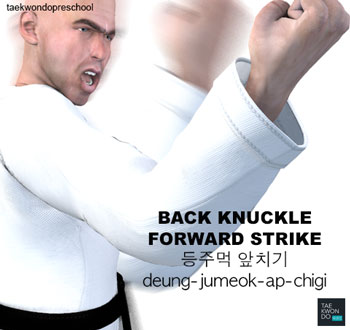
Back Knuckle Forward Strike ( 등주먹 앞치기 deung-jumeok-ap-chigi ) is an intermediate technique striking with the back knuckle ( 등주먹 deung-jumeok ). The fist should pass over from the opposite waist to the armpit, to the chin level and then hitting with the back of the fist to the opponent's face. Focus on the tightening of the muscles of the hand while you clench a fist ( 주먹 jumeok ). If the wrist ( 팔목 palmok ) bends on impact, it can easily be sprained, dislocated or broken.
View Back Knuckle Forward Strike ( 등주먹 앞치기 deung-jumeok-ap-chigi ) »
Question. What is the korean terminology for Elbow Target Strike?
Answer you gave was: ( 팔굽 표적치기 palgup-pyojeok-chigi )
Your answer is correct! Great Job!

The elbow ( 팔굽 palgup ) hits the Palm ( 손바닥 sonbadak ) of the other arm and the height is around the solar plexus. In self-defense, the practitioner would reach out and grab the opponents neck ( 목 mok ). When pulling forward the opponents neck, the practitioner would perform an elbow strike to the opponents face ( 얼굴 eolgul ) striking directly to the nose ( 코 ko ) or eyes ( 눈 nun ) as suitable targets.
Question. What is the korean terminology for Elbow Target Strike?
Answer you gave was: ( 바깥막기 momtong-bakkat-makgi )
Your answer is wrong! You need to study more!

An Outside Middle Block ( 바깥막기 momtong-bakkat-makgi ) deflects a strike away from the defender leaving an opportunity for a counterattack. For example, against a straight punch to the chest area, the block would aim to meet the forearm of the attacker, pushing the punch outwards causing it to miss, and then most commonly leaving the defender slightly to the side to counterattack the opponent.
Question. What is the name of Taegeuk #6 in Korean?
Taegeuk 태극 (in World Taekwondo (WT)) refers to a set of poomse 품새 used to create a foundation for the teaching of taekwondo. A poomse or form is a detailed pattern of defense-and-attack motions and techniques used in traditional martial arts. Each taegeuk form symbolizes a specific state thought to be indicative of the belt the student currently holds, and is represented in World Taekwondo (WT) by trigrams similar to those found in the four corners of the South Korean flag.
Question. What is the name of Taegeuk #6 in Korean?
Answer you gave was: Yuk Jang
Your answer is correct! Great Job!


The trigram associated with this poomse represents Water. Also, there is a relation to West and the relationship with a Second son. The movements of this poomse are intended to be performed like water; flowing, powerful and cleansing. Sometimes standing still like water in a lake, sometimes thriving as a river, sometimes powerful like a waterfall.
Question. What is the name of Taegeuk #6 in Korean?
Answer you gave was: O Jang
Your answer is wrong! You need to study more!


The trigram associated with this poomse represents Wind. The trigram is also related to southwest and the relationship with an eldest daughter. The I Ching promotes that wind is a gentle force, but can sometimes be furious, destroying everything in its path. As such, it is intended that this poomse is performed like the wind: gently, but knowing the ability of mass destruction with a single movement.
Question. What is the name of Taegeuk #6 in Korean?
Answer you gave was: Sa Jang
Your answer is wrong! You need to study more!


This trigram represents Thunder. Also, the trigram is strongly connected to northeast and the relationship of the Eldest son. Thunder comes from the sky and is absorbed by the earth, thus, according to the beliefs of the I Ching, thunder is one of the most powerful natural forces. This poomse is associated with power and the connection between the heavens and earth.
Question. What is the name of Taegeuk #6 in Korean?
Answer you gave was: Chil Jang
Your answer is wrong! You need to study more!


The trigram associated with this poomse represents a Mountain. Also, it represents the northwest and youngest son. The symbolism behind the mountain is the indomitable and majestic nature that all mountains possess. This poomse is intended to be performed with the feeling that all movements are this majestic due to their unconquerable nature.
Question. What is the name of Taegeuk #8 in Korean?
The trigram associated with this poomse represents the Earth. Also, there is a representation of North and Mother. The associated trigram of this poomse is Yin. Yin, here, represents the end of the beginning, the evil part of all that is good. This being the last of the poomse Taegeuk, it represents the end of the circle and the cyclic nature of the Earth.
Question. What is the name of Taegeuk #8 in Korean?
Answer you gave was: Chil Jang
Your answer is wrong! You need to study more!


The trigram associated with this poomse represents a Mountain. Also, it represents the northwest and youngest son. The symbolism behind the mountain is the indomitable and majestic nature that all mountains possess. This poomse is intended to be performed with the feeling that all movements are this majestic due to their unconquerable nature.
Question. What is the name of Taegeuk #8 in Korean?
Answer you gave was: Yuk Jang
Your answer is wrong! You need to study more!


The trigram associated with this poomse represents Water. Also, there is a relation to West and the relationship with a Second son. The movements of this poomse are intended to be performed like water; flowing, powerful and cleansing. Sometimes standing still like water in a lake, sometimes thriving as a river, sometimes powerful like a waterfall.
Question. What is the name of Taegeuk #8 in Korean?
Answer you gave was: Sam Jang
Your answer is wrong! You need to study more!


This trigram represents Fire. Related to this symbol is also East and the relationship of the Second Daughter. Fire contains a lot of energy. The symbol behind the fire is similar to the symbolism of the water in that both can aid and both can destroy. This form is intended to be performed rhythmically, with some outbursts of energy to reflect fire's rhythmic and energetic dualism.
Question. What is the name of Taegeuk #8 in Korean?
Answer you gave was: Pal Jang
Your answer is correct! Great Job!


The trigram associated with this poomse represents the Earth. Also, there is a representation of North and Mother. The associated trigram of this poomse is Yin. Yin, here, represents the end of the beginning, the evil part of all that is good. This being the last of the poomse Taegeuk, it represents the end of the circle and the cyclic nature of the Earth.


Related Information
In martial arts, blocking ( 막기 makgi ) is the act of stopping or deflecting an opponent's attack for the purpose of preventing injurious contact with the body. A block ( 막기 makgi ) usually consists of placing a limb across the line of the attack. Blocks ( 막기 makgi ) are considered by some to be the most direct and least subtle of defensive techniques. Other ways of avoiding attack include evasion, trapping, slipping and deflection of the oncoming attack; this approach is often referred to as the application of 'soft' techniques.
View all taekwondo blocks on the Blocks ( 막기 makgi ) Main Section »
- Low Block ( 아래막기 arae-makgi )
- Middle Block ( 몸통막기 momtong-makgi )
- High Block ( 올려막기 olgul-makgi )
- Outside Block ( 바깥막기 momtong-bakkat-makgi )
- High Outside Block ( 올려 바깥막기 olgul-bakkat-makgi )
- Single Knife Hand Outward Block ( 한손날 바깥막기 hansonnal-bakkat-makgi )
- Inward Knife Hand Block ( 손날 안막기 sonnal-an-makgi )
- Hand Blade Low Block ( 한손날 아래막기 sonnal-arae-makgi )
- Hand Blade Twist Outward Block ( 손날 비틀어 바깥막기 sonnal-bitureo-bakkat-makgi )
- Pressing Block ( 눌러막기 nulleo-makgi )
- Palm Heel Pressing Block ( 바탕손 눌러막기 batangson-nulleo-makgi )
- Palm Heel Inward Block ( 바탕손 안막기 batangson-an-makgi )
- Palm Heel Assisted Block ( 바탕손 거들어 몸통막기 batangson-kodureo-momtong-makgi )
- Cross Block ( 엇걸어막기 otgoreo-makgi )
- Low Cross Block ( 아래 엇걸어막기 arae-otgoreo-makgi )
- High Cross Blocking ( 올려 엇걸어막기 olgul-otgoreo-makgi )
- Knife Hand High Cross Block ( 손날 엇걸어막기 sonnal-olgul-otgoreo-makgi )
- Inner Wrist Outer Block ( 안팔목 바깥막기 anpalmok-bakkat-makgi )
- Trunk Push Double Block ( 헤쳐막기 hecho-makgi )
- Trunk Push Low Block ( 아래 헤쳐막기 arae-hecho-makgi )
- Outside Wrist Double Block ( 바깥팔목 헤쳐막기 bakkat-palmok-hecho-makgi )
- Inside Wrist Double Block ( 안팔목 헤쳐막기 anpalmok-hecho-makgi )
- Hand Blade Double Block ( 손날 헤쳐막기 sonnal-hecho-makgi )
- Ridgehand Double Block ( 손날등 헤쳐막기 sonnal-deung-hecho-makgi )
- Outside Wrist Pressing Block ( 바깥팔목 눌러막기 bakkatpalmok-nulleo-makgi )
- Bent Wrist Outward Block ( 굽힌손목 바깥막기 gupinsonmok-bakkat-makgi )
- Kicking Block ( 차막기 cha-makgi )
- Outward Kicking Block ( 바깥 차막기 bakkat-cha-makgi )
- Inward Kicking Block ( 안 차막기 an-cha-makgi )
- Front Kicking Block ( 앞 차막기 ap-cha-makgi )
- Side Kicking Block ( 옆 차막기 yeop-cha-makgi )
- Wide Open Mountain Block ( 산틀막기 santeul-makgi )
- Single Hand Wide Open Block ( 외산틀막기 wesanteul-makgi )
- Bull Horn Block ( 황소막기 hwangso-makgi )
- Scissors Block ( 가위막기 kawi-makgi )
- Diamond Block ( 금강막기 keumgang-makgi )
- Keumgang Downward Side Block ( 금강 내려 옆 막기 keumgang-naeryeo-yeop-makgi )
- Keumgang Outward Block ( 금강 바깥막기 keumgang-bakkat-makgi )
- Hand Blade Diamond Downward Side Block ( 손날 금강 내려 옆 막기 sonnal-keumgang-naeryeo-yeop-makgi )
- Hand Blade Diamond Outward Block ( 손날 금강 바깥막기 sonnal-keumgang-bakkat-makgi )
- Supported Trunk Block ( 거들어막기 momtong-kodureo-makgi )
- Supported Hand Blade Block ( 손날 거들어 바깥막기 sonnal-kodureo-makgi )
- Supported Downward Hand Blade Block ( 손날 거들어 내려막기 sonnal-kodureo-naeryeo-makgi )
- Outside Wrist Supported Trunk Block ( 바깥팔목 거들어 바깥막기 bakkatpalmok-kodureo-bakkat-makgi )
- Supported Downward Block ( 거들어 내려막기 kodureo-naeryeo-makgi )
- Ridgehand Outward Block ( 손날등 바깥막기 sonnal-deung-bakkat-makgi )
- Ridgehand Supporting Downward Block ( 손날등 거들어 내려막기 sonnal-deung-kodureo-naeryeo-makgi )
- Side Block ( 옆막기 yeop-makgi )
- Low Side Block ( 아래 옆막기 arae-yeop-makgi )
- Inside Wrist Side Block ( 안팔목 옆막기 anpalmok-yeop-makgi )
- Outside Wrist Side Block ( 바깥팔목 옆막기 bakkat-palmok-yeop-makgi )
- Ridgehand Side Block ( 손날등 옆막기 sonnal-deung-yeop-makgi )
- Hand Blade Side Block ( 손날 옆막기 sonnal-yeop-makgi )
- Inner Wrist Supporting Side Block ( 안팔목 거들어 옆막기 anpalmok-kodureo-yeop-makgi )
- Inner Wrist Supporting Outward Block ( 안팔목 거들어 바깥막기 anpalmok-kodureo-bakkat-makgi )
- Palm Assisting Outer Block ( 손바닥 거들어 바깥막기 sonbadak-kodureo-bakkat-makgi )
- Target Block ( 표적 막기 pyojeok-makgi )
- Underneath Target Block ( 아래 표적 막기 arae-pyojeok-makgi )
There are five tenets defined in the International Taekwondo Federation (ITF) and several more in World Taekwondo (WT).
Integrity ( 염치 yeom-chi ): "Although it may be similar, this form of integrity takes on a more wider role then defined in the common dictionary. In taekwondo, integrity means not only to determine what is right or wrong but also having the conscience to feel guilt if one has done wrong and to have the integrity stand up for what is right." View Taekwondo Tenets »
RESOURCES
This article uses material from the Wikipedia article "List of Taekwondo Techniques", which is released under the Creative Commons Attribution-Share-Alike License 3.0.








